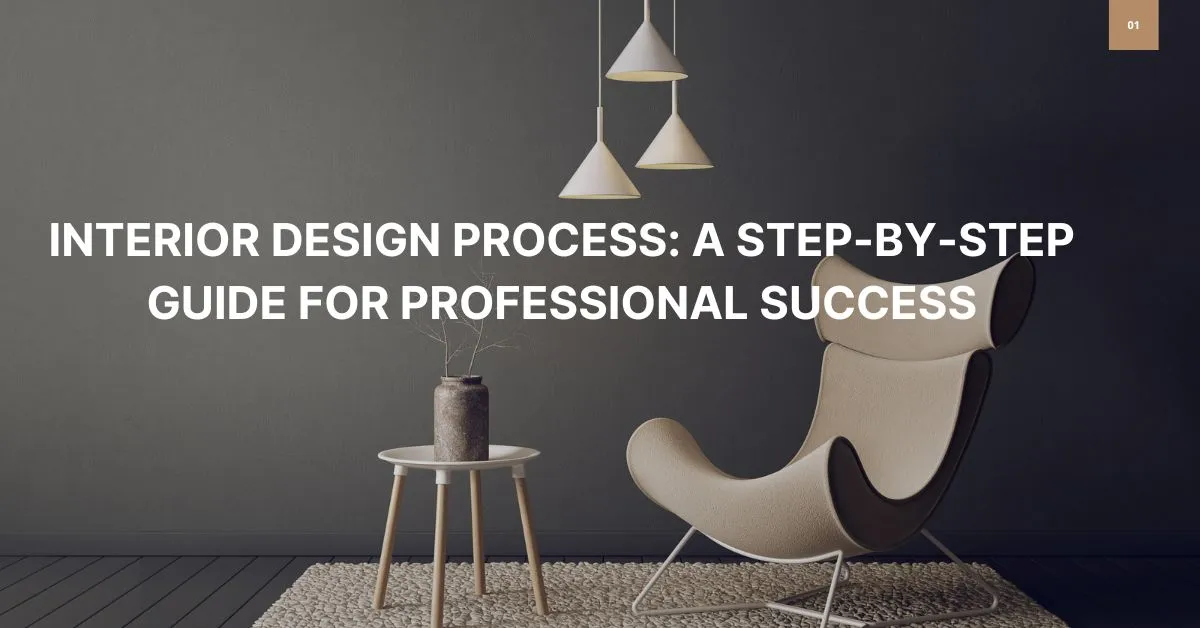Hello fellow design enthusiasts and aspiring visionaries ! It’s your blogger passionate here,and today we're diving deep into the very heart of what makes an interior design project not just good but exceptional truly: a meticulously crafted interior process design. If you’re a beginner designer, perhaps feeling a mix exhilarating of excitement and nervous trepidation about transforming spaces then you’re in exactly the right place . Learn More
I remember standing where you are now – with brimming creativity , bursting with ideas but perhaps a little unsure how to channel that artistic energy into a structured professional and successful journey client. My first projects few were a whirlwind of intuition and improvisation and while they eventually found their way , I quickly learned the invaluable lesson that a clear step-by-step interior design process isn't just a professional nicety; it's your compass your map and your ultimate secret weapon for consistent success . It’s what transforms scattered ideas into coherent breathtaking realities and,crucially builds trust with your clients. This guide isn't just about what to do but how to build a repeatable reliable process that empowers you to create stunning interiors and thrive in this incredible industry.
What's the First Step in Turning a Dream a into Blueprint? The Discovery Phase
Every remarkable transformation begins with a a conversation deep dive into the client's world ,desires, and challenges. This isn't just about collecting data; it's about connecting on a human level , understanding their lifestyle their aspirations, and even their fears about the design process. Imagine sitting down with a potential client not as a salesperson but as a detective piecing together clues to solve their spatial puzzle.
The Initial Spark: Client Consultation
This initial meeting is your chance to shine and build immediate rapport .It's where you listen more than you speak. I once had a client who initially told they me wanted a minimalist space but after an hour of gentle probing and open-ended questions, I discovered their true desire was a cozy layered environment that felt minimalist because was it clutter-free and highly functional.Without that deeper conversation I might have designed something they disliked.
Listening with Purpose
Ask open-ended questions: "How do you envision spending your mornings here? " "What feeling do you want to evoke when you walk through that door? " "What are your non-negotiables,and what are you flexible on? " Pay attention to not just their words, but their body language , their hesitations, excitement their.These subtle cues are gold.
Setting Expectations
Equally important educating is the client about your interior design process. Explain the phases,the typical timeline your fee structure , and how you communicate .Transparency from the outset builds trust manages and expectations preventing down misunderstandings the line. A clear roadmap makes journey the less daunting for both of you.
Unearthing the Needs: Project Brief Development
Following the consultation you'll formalize into everything a comprehensive project brief. This document is the cornerstone of entire your interior design process. It outlines the scope of work,budget parameters, timeline functional requirements aesthetic preferences and a detailed list of spaces to be addressed . It's a living document guides that decision every you make.
Beyond Aesthetics
While aesthetics are crucial the brief must delve into function . Do they need ample storage? Is the space for entertaining large groups or intimate family gatherings? Are there specific accessibility needs? Consider every aspect of how the space will be lived in not just how it will look.
How Do You Translate Ideas into Tangible Visions ? The Conceptualization & Phase Design
Once you understand the client's needs the real magic begins: translating their abstract dreams into concrete inspiring design concepts.This is where your creativity takes center stage but always the within framework of the established brief.Think of yourself as an architect of emotions,crafting spaces that resonate deeply .
Brainstorming & Inspiration
This phase is about exploration. You'll gather inspiration from sources various – art nature, travel , fashion – and let your ideas flow freely.For me this often starts with a messy sketchbook and moves towards more refined visual tools.
Mood Boards & Concept Development
Mood boards are powerful tools.They are visual collages of images, textures colors , and even small samples convey that the overall feeling and aesthetic direction of the proposed design.They're not about specific furniture pieces yet , but about the vibe. This allows the client to react to the emotional essence of the design before invest you time in detailed plans . I vividly remember a client tearing up when I showed her a mood board for her new nursery – that emotional connection told me I was on the right track .
Bringing it to Life: Space Planning & Schematics
With the concept approved you move into the technical heart of the interior design process: detailed space planning . This involves creating floor plans , furniture layouts and preliminary elevations that optimize flow, function and aesthetics within the given constraints.
Flow and Function
Every piece of furniture every doorway, every pathway is meticulously considered to ensure the space works harmoniously.This requires a strong understanding of scale, proportion, and ergonomics. It’s where your technical skills truly shine .
The Details Emerge: Material & Finishes Selection
Here, you'll specify materials, finishes, lighting fixtures, and preliminary furniture selections align that with the approved concept and budget . This is where you get to play with textures patterns and the tactile elements that bring warmth and character to a space.
Is Your Clear Vision to Enough Inspire Confidence? The Presentation & Approval Phase
You’ve poured heart your and expertise into crafting a brilliant design. Now comes the critical step of presenting it your to client in a way that not only showcases your vision but also empowers them to make informed decisions and feel truly excited about the transformation.This is not just a show-and-tell; it’s a compelling narrative .
Crafting a Compelling Narrative
presentation Your should tell a story.Walk your clients through the journey, reminding them of their needs initial and how your design address solutions them . Use a mix of visuals – 3D renderings floor plans , boards material – and clear concise explanations .
Visualizing the Future
High-quality 3D renderings can be transformative allowing clients to virtually "into step" their new space .I recall a client who struggled to visualize from floor plans alone; a rendering of their proposed kitchen instantly ignited their excitement and secured their enthusiastic approval. It bridges the gap between abstract plans and tangible reality.
The Art of Client Feedback
Anticipate questions and be prepared for feedback. This is a collaborative process , and client input is vital. Listen actively , take detailed notes , and differentiate between subjective preferences and critical design flaws .
Revisions and Refinement
Incorporate feedback thoughtfully. Present revisions clearly, explaining the changes and their implications. This iterative process ensures final the design truly reflects the client’s desires while maintaining your professional integrity and vision. This phase is crucial for client satisfaction and is an integral part of a successful interior design process.
From Paper to Reality: How Do You Ensure Flawless Execution?The Implementation Phase
This is where the detailed plans and approved concepts begin their transformation into a tangible space . It's a phase that demands meticulous organization strong communication and robust problem-solving skills.As a beginner,you'll quickly learn that true design success isn'just t aesthetics about; it'about s efficient project management.
Procurement & Logistics
Once the design is approved the process of ordering materials,furniture, and fixtures begins . This involves managing vendor relationships, negotiating pricing,tracking orders and coordinating deliveries. It’s a logistical ballet where timing is everything .
Vendor Relationships
Building strong relationships with reliable vendors and contractors is paramount . They are an extension of your team , and their professionalism directly impacts your project's success and your client's experience. Always verify lead times and communicate any potential delays promptly.My trusted network of suppliers has saved me from countless over headaches the years .
Management Project & Oversight
During this phase , you’oversee ll the installation, construction, and renovation work ensuring everything adheres to the design specifications budget, and timeline.This often means daily check-ins troubleshooting unexpected issues , and coordinating various trades .
Visits Site & Quality Control
Regular site visits are non-negotiable . They allow you to catch potential issues early ensure quality craftsmanship and keep the project moving forward . have Always a critical eye,comparing the work against your detailed drawings and specifications.This hands-on involvement is crucial to maintaining the integrity of your interior design process.
What Defines a Project's True Success? The Post-Completion & Celebration Phase
The final stage of the interior design process is where your vision truly comes to life ,ready to be enjoyed by the client. But the work isn'quite t done. This phase ensures client satisfaction provides closure , and helps you learn and grow for future projects.
The Final Walk-Through
Once all installations are complete , a conduct thorough walk-through with your client. This is your opportunity to showcase finished the space and address any last-details minute.
Addressing Punch List Items
Create a "punch list" of any minor touch-ups or outstanding items. This demonstrates your commitment to perfection and ensures the client's complete satisfaction before payment final. This attention to detail at the very end leaves a lasting positive impression.
Client Handover & Follow-Up
Provide your client with all necessary documentation, including warranties , care instructions for materials, and contact information for any installers or suppliers.A follow-up call or email a few weeks later can also strengthen your relationship and lead potentially to referrals.
Capturing the Transformation: Photography
Professional photography of the completed project is essential. These images are your portfolio , showcasing your talent and hard work. They are the visual testimonials that attract new clients and allow you to celebrate the incredible you transformation’ve orchestrated. Seeing the before-and-after of a space you've lovingly created is one of the most rewarding aspects of this profession .
Embracing a structured interior design process doesn't stifle creativity; it liberates it.It provides the framework within which your artistic genius can flourish ensuring that every project from the smallest refresh to the grandest renovation is executed with professionalism precision and a touch of your unique magic. by Step step , you’ll not only build stunning spaces but also a thriving , respected career . Go forth and design with confidence!
Description Meta: Master the interior design process with this comprehensive,step-by-step guide for beginner designers . Learn how achieve to professional success .


